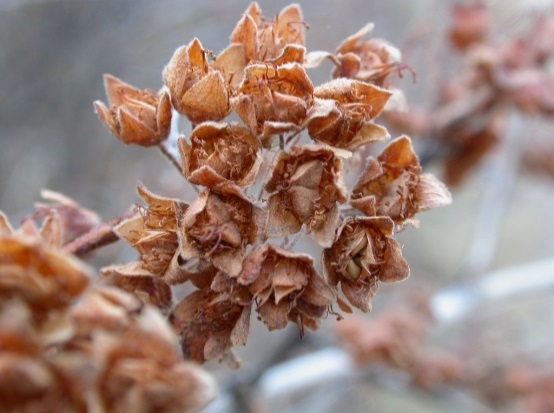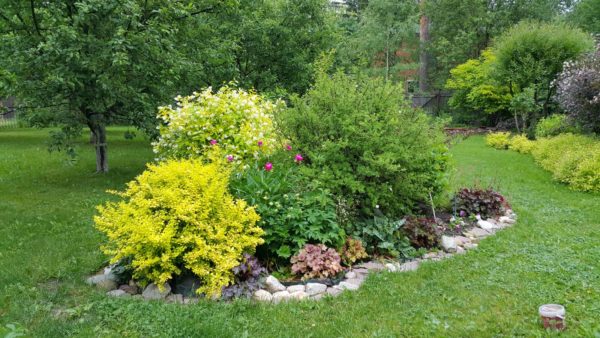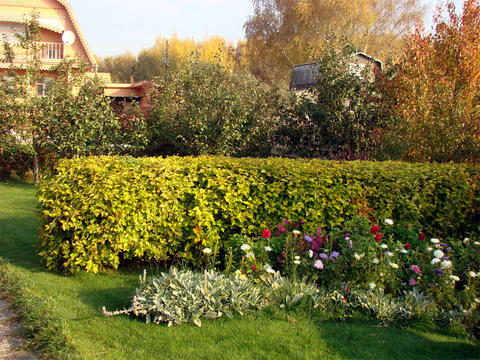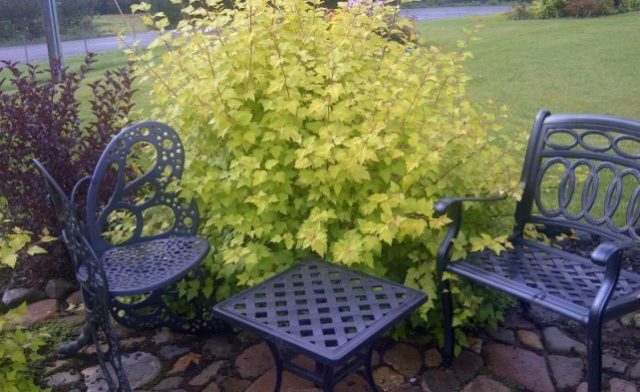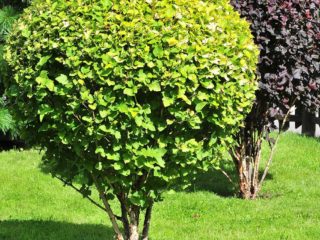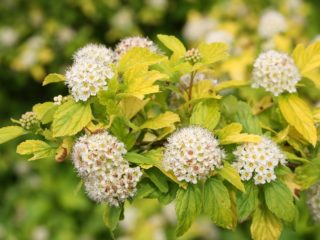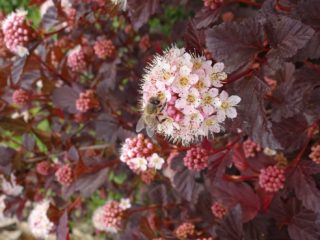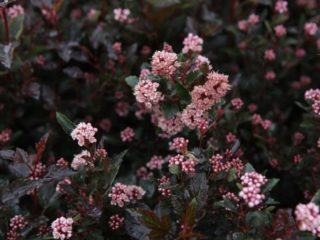Content
The basis of the landscape ensembles of gardens and parks located in zones with a temperate climate are frost-resistant, undemanding plants that maintain the effectiveness of the compositions for a long time. These characteristics are possessed by the viburnum vesicle Aurea. The yellow crown of this shrub adds color and vibrancy to the design of home gardens and urban areas.
Description of the vesicle Aurea
Bubble (spirea) is an unpretentious decorative deciduous shrub belonging to the Pink family. His homeland is the eastern regions of Asia and North America. Under natural conditions, it grows in valleys and on the banks of rivers, in mixed forests.
Popularity for landscape design has acquired the cultivar of the viburnum Aurea. This shrub up to 2.5 m high and up to 3 - 4 m wide has the following characteristics:
- the brown or brownish bark of the plant exfoliates with age in longitudinal stripes;
- oblong rounded leaves with 3 - 5 lobes with serrate-toothed edges are colored unevenly in yellow: the upper side is a saturated shade, the lower side is lighter;
- white flowers are collected in 10 - 15 pieces. in convex corymbose inflorescences;
- small fruits in the form of inflated bubbles-leaflets connected in infructescence burst when pressed.
This description is demonstrated by a photo of the cultivar of the viburnum variety Aurea.
Aurea cultivar blooms in June-July for 20 - 25 days. The color of its leaves during the growing season changes: when blooming, they are reddish, at the beginning of summer - yellow. During the flowering of the shrub, the foliage fades, but by the beginning of autumn it again acquires a bright orange tint. Maximum coloration is achieved in sunny locations. In the shade, the leaves turn dull green.
During the year, the culture grows by about 0.5 m. It reaches the height of an adult plant in three to four years. The lifespan of the vesicle Aurea is up to 30 years.
Bubble-leaf Vine-leaved Aurea in landscape design
Due to its decorative effect and good pliability to haircuts, the Aurea cultivar is used in the design of personal plots, parks, gardens, and public gardens. It is not characterized by the brightness of flowering. This shrub attracts more attention by the color of the leaves and the original forms of the crown.
Some types of landscape design in which the Aurea bubblegum looks impressive:
- Mixborders. The yellow foliage of this plant illuminates the background of the shrub group when arranging a one-sided mixborder. If a two-sided option is organized, then Aurea is placed as a tapeworm, surrounding it with lower representatives of the flora.Important! Mixborder is a free-flowing flower garden.
The photo shows a variant of a mixborder with Aurea vesicle.
- Contrasting compositions. Shrub color enhances the use of contrast in the garden. The light color of the leaves of Aurea is emphasized by darker conifers and deciduous plants. It also looks great in combination with red-leaved bladder varieties such as Diablo or Red Baron.
- Hedges. A trimmed, regular geometric hedge made of a bubble-tree is an exquisite element of decor. It fits into modern urban courtyards where there is no room for large trees. It can be used to enclose a playground or a sports ground. Fences above eye level create a sense of isolation. In gardens and squares, they are used to organize U-shaped niches for recreation.
- Curbs. It is possible to zon the space of the urban area or to make the decor of the personal plot splendid and complete by forming a 40 - 60 cm high border from the vesicle. Arabesques created from this shrub look attractive.Advice! To make an arabesque (ornamental border flower bed), they draw a sketch on graph paper, transfer it to scale on the ground. Shrub seedlings are planted according to the resulting pattern at a distance of 20 - 50 cm. In a year or two they will grow up, forming a unique pattern.
- Emphasis on well-groomed lawns. The plant is placed as a tapeworm on a green area. Periodically pinching its shoots and carefully trimming, they achieve the smooth shape of the Aurea vesicle.
Growing conditions for the cultivar of the viburnum variety Aurea
The Aurea variety is unpretentious to the composition of the soil and the sunshine of the area, it is frost-resistant and drought-resistant. In order to fully reveal the varietal characteristics of the plant, the following conditions for its cultivation are recommended:
- loose, slightly acidic drained soils that allow oxygen to pass through are preferred;
- undesirable close location of groundwater and land with a high lime content;
- the plant is shade-tolerant, but when choosing a place for planting, the advantage should be given to open, well-lit areas.
Planting and caring for the vesicle Aurea
Compliance with the planting rules and appropriate care for the Aurea cultivar of viburnum bladder will allow you to grow a beautiful plant with bright foliage and protect it from diseases.
Landing site preparation
The best option for growing the Aurea cultivar is medium loam, containing a large amount of humus. The nutrient substrate for planting it can be prepared independently using one of the following methods:
- mix in a 1: 1: 2 ratio of leafy earth, humus and sand;
- combine turf, peat and sand in a ratio of 1: 2: 2.
Plants for individual compositions are planted in the wells. When organizing curbs and hedges, trenches are made. They should have a depth and width of 40-50 cm. They are prepared two to three weeks before planting and a fertile mixture is poured into them.
Landing rules
In order for the Aurea vesicle bush to take root, you should adhere to the following rules:
- When planting, no fertilizer is applied to the soil. A young plant cannot fully assimilate them.
- The seedling is placed in the hole together with the earthen lump strictly vertically.
- The hole is covered with earth in portions, compacting each layer.
- After planting, the shrub is well watered.
- If, after watering the plant, the earth has settled, then the soil is poured to the level of the root collar.
- The surface of the hole is mulched with peat or humus.
Watering and feeding
Watering and fertilizing are important steps in the care of the Aurea bladderwort. Watering rules:
- In case of drought in extreme heat, the plant is watered at least 2 times a week.
- Water is poured in small doses at the root.
- Stagnation of water at the roots of the shrub should be avoided, otherwise it can lead to infection with powdery mildew.
Aurea is fed twice a year:
- in spring - nitrogen-containing fertilizers (urea, ammonium nitrate);
- in the fall - with mineral dressing, for example, nitroammophos (1 matchbox per bucket of water).
Pruning
Aurea bladderworm tolerates the pruning procedure well. It is cut in order to:
- stimulate active growth of shoots;
- give the crown the necessary shape;
- make sanitary pruning.
When forming the crown of the Aurea vesicle, the following pruning methods are used:
- if it is necessary to get a powerful, wide shrub with a large number of trunks, then it is cut off at a level of 40 - 50 cm;
- if the plant is given the shape of a fountain, then thin branches are removed, leaving up to five strong shoots, which are cut to a height of 1.5 m.
Preparing for winter
Aurea cultivar is a frost-resistant shrub. In the middle lane for the winter it is not sheltered. Rarely, after severe frosts, the tops of the plant may freeze slightly.
Newly rooted young shoots require special preparation for winter. In autumn, the soil around them is mulched with peat with a layer of 8 cm. Then the plants are covered with spruce branches.
Reproduction
The bicarp of the Aurea variety is propagated by seeds, cuttings, dividing the bush or layering.
- Reproduction by seeds. This method is rarely used for bladderworms. Despite the high germination capacity, it is likely that the varietal characteristics of the plant, for example, the color of the leaves, will not be preserved.
- Cuttings. An effective and fast way of propagation is cuttings. For him, green shoots are used, cut into 10 - 20 cm, with several points of growth. To prepare the cutting, a thick, healthy branch is separated from the shrub before flowering, the leaves are removed from its lower part, and half is cut off from the upper part. For several hours, the base of the cutting is immersed in a solution of rooting stimulants. Then it is planted in sand or a soil mixture of sand and peat, watered, covered with polyethylene. Before the appearance of leaves and shoots, the young plant is periodically ventilated and watered. Then the film is removed from the bushes. For the winter, they are covered with spruce paws. The soil around them is mulched with peat, leaves or earth. In the spring, a new vesicle is transplanted to a permanent place.
- Division of the bush. The disadvantage of this method is the application of significant physical effort and a small amount of new plants obtained. The division is carried out in early spring or late autumn. The shrub is cut to 60 - 70 cm, then dug out, removing the entire root system from the soil, and the bush is divided into 4 - 6 parts. The vesicles are immediately transplanted into pre-prepared holes, preventing their rhizomes from drying out. After it is watered, and the soil is mulched. In the first year, new plants are covered for the winter.Attention! The division of the Aurea vesicle is carried out so that each new plant gets good roots and a long, healthy, powerful branch.
- Reproduction of the vesicle by layering. The optimal time for this method is early April, after the first leaves appear. On the bladder of the Aurea variety, a developed outward shoot is chosen, from which the leaves are removed, leaving a few at the top. A ditch with a depth of 12 - 15 cm is made under it. Layers are laid in it, without cutting off from the bush, fixed and sprinkled with fertile soil. The tip is not covered with earth. In a drought, the shrub is watered abundantly. In autumn, the rooted vesicle is separated from the parent plant. For the winter, it is covered with spruce branches.
Diseases and pests
The varietal feature of the Aurea vesicle is resistance to diseases and pests. In rare cases, with improper care, underfeeding, excessive watering, improper pruning, the shrub can be affected by chlorosis.A symptom of a plant disease is yellowing of leaves on young shoots and drying of the apical stems.
Conclusion
Aurea bubble plant is used to implement landscape solutions of various shapes and purposes. This highly decorative plant will decorate single and group plantings. Shrub seedlings are affordable, take root well, do not require special care and growing conditions.


